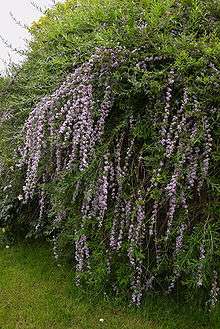Buddleja alternifolia
| Buddleja alternifolia | |
|---|---|
 | |
| Scientific classification | |
| Kingdom: | Plantae |
| (unranked): | Angiosperms |
| (unranked): | Eudicots |
| (unranked): | Asterids |
| Order: | Lamiales |
| Family: | Buddlejaceae |
| Genus: | Buddleja |
| Species: | B. alternifolia |
| Binomial name | |
| Buddleja alternifolia Maxim. | |
| Synonyms | |
| |
Buddleja alternifolia, known as alternate-leaved butterfly-bush,[1] is endemic to Kansu, China, where it grows along river banks in thickets at elevations of 1,500 – 4,000 m. First described and named by Carl Maximowicz [2] in 1880, the plant was not introduced to cultivation until 1915, by Purdom and Farrer.[3] [4] B. alternifolia was accorded the Royal Horticultural Society's Award of Garden Merit (record 674) in 1993.[5][6]
Buddleja alternifolia, after Leeuwenberg
In his 1979 revision of the taxonomy of the African and Asiatic species of Buddleja, the Dutch botanist Anthonius Leeuwenberg sank two species, B. legendrei and B. tsetangensis, as B. alternifolia on the basis of the similarity in the individual flowers, dismissing the variations in plant structure, flower colour and leaf as attributable to environmental factors.[4] It was Leeuwenberg's taxonomy which was adopted in the Flora of China[7] published in 1996. Until DNA analysis can prove otherwise, it is this classification which is accepted here.
Description

B. alternifolia is a vigorous deciduous shrub reaching 5 m (16 ft) tall with long, slender, pendulous stems. The leaves are alternate, entire, and lanceolate, 4–10 cm long by 0.6–1 cm wide, glabrous and dark green above. The inflorescences of the plants in cultivation are bright lilac-purple, and comprise flowers so densely crowded in clusters along the branch as to often obscure it. However, specimens from the Tsangpo valley in Tibet originally named B. tsetangensis by Marquand have creamy flowers. Flowering occurs in early summer; the flowers are fragrant, but less so than other buddlejas.[3] 2n = 38.[8]
Cultivation
The species has become very common in cultivation, a popular shrub for the larger garden, and is readily available from most garden centres in the UK. Fully hardy, it prefers a sunny position and loamy soil; pruning should immediately follow flowering. Like most buddlejas, the species is easily propagated from cuttings.[3] Hardiness: RHS H5, USDA zones 7 – 9.[9]
Cultivars
References
- ↑ "BSBI List 2007". Botanical Society of Britain and Ireland. Archived from the original (xls) on 2015-02-25. Retrieved 2014-10-17.
- ↑ Maximowicz, (1880). Bull. Acad. Pétersb. xxvi. 494. 1880.
- 1 2 3 Bean, W. J. (1917). Trees and shrubs hardy in Great Britain, 7th edition. Murray, London.
- 1 2 Leeuwenberg, A. J. M. (1979) The Loganiaceae of Africa XVIII Buddleja L. II, Revision of the African & Asiatic species. H. Veenman & Zonen, Wageningen, Nederland.
- ↑ "RHS Plant Selector - Buddleja alternifolia". Retrieved 18 June 2013.
- ↑ "RHS AGM Listing May 2013 (Ornamentals)". Archived from the original on 8 June 2013. Retrieved 18 June 2013.
- ↑ Li, P-T. & Leeuwenberg, A. J. M. (1996). Loganiaceae, in Wu, Z. & Raven, P. (eds) Flora of China, Vol. 15. Science Press, Beijing, and Missouri Botanical Garden Press, St. Louis, USA. online at www.efloras.org
- ↑ Chen, G, Sun, W-B, & Sun, H. (2007). Ploidy variation in Buddleja L. (Buddlejaceae) in the Sino - Himalayan region and its biogeographical implications. Botanical Journal of the Linnean Society. 2007, 154, 305 – 312. The Linnean Society of London.
- ↑ Stuart, D. D. (2006). Buddlejas. RHS Plant Collector Guide. Timber Press, Oregon. ISBN 978-0-88192-688-0.
- Hillier & Sons. (1977). Hilliers' Manual of Trees and Shrubs. David & Charles, Newton Abbot, UK
| Wikimedia Commons has media related to Buddleja alternifolia. |